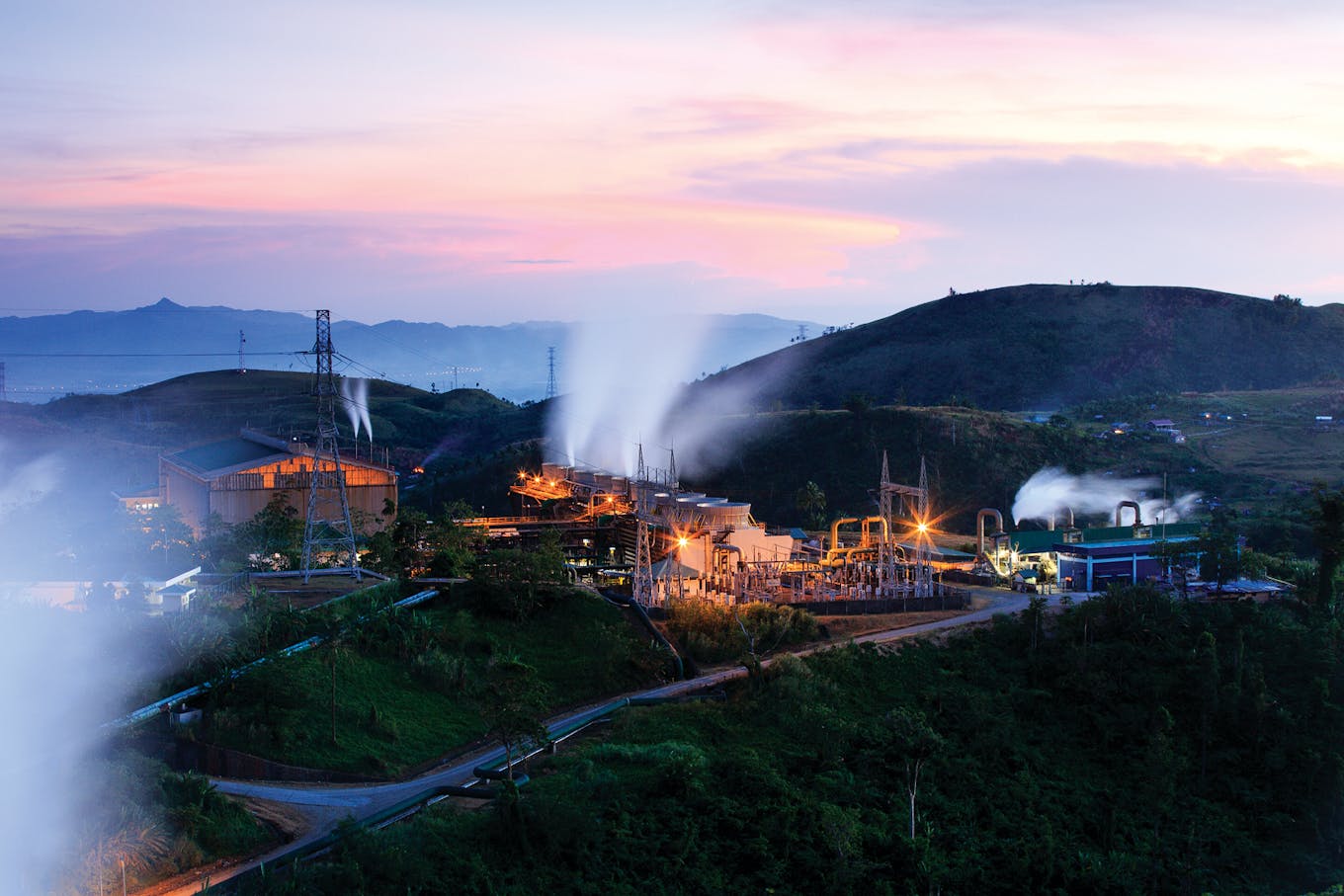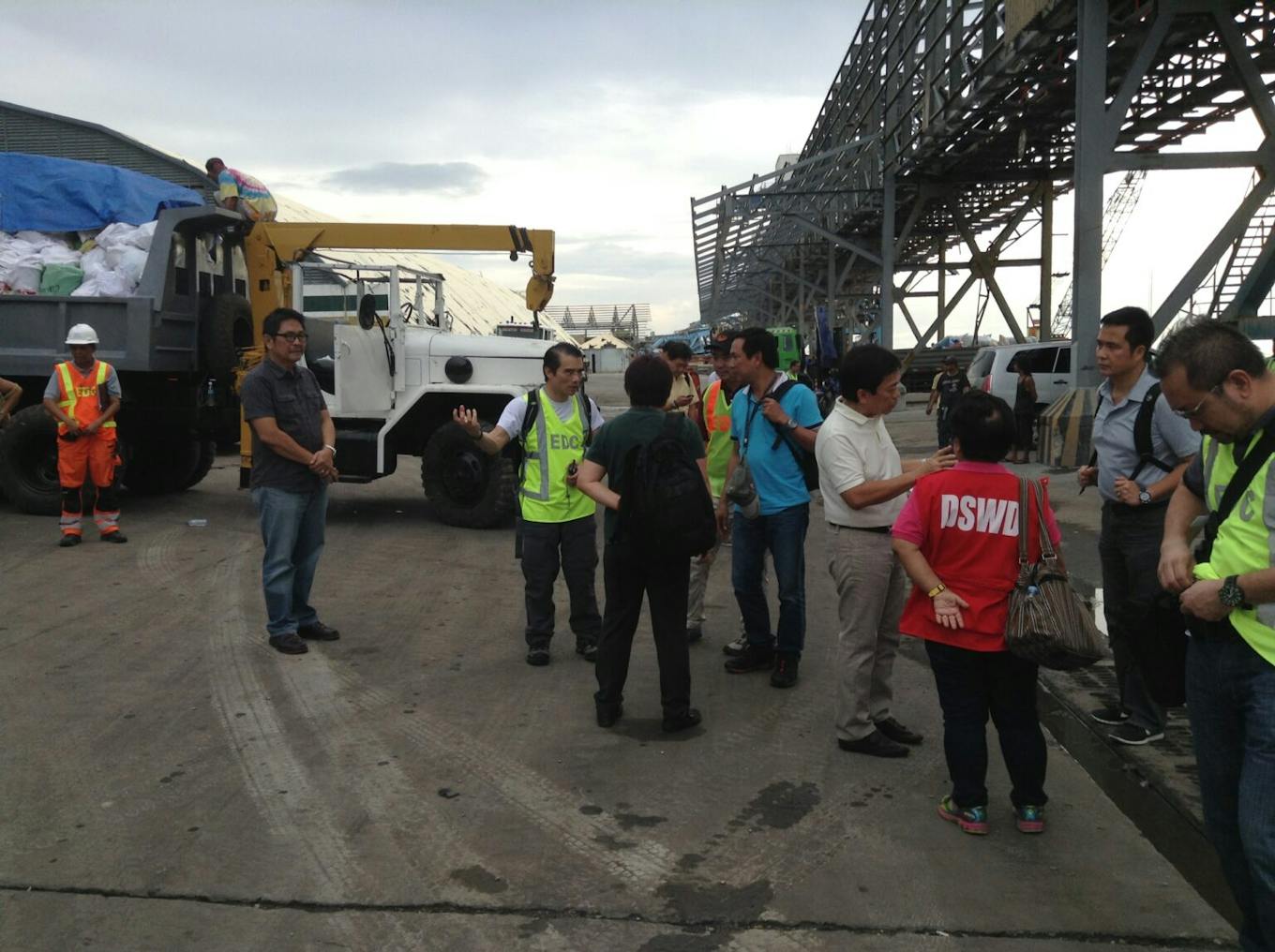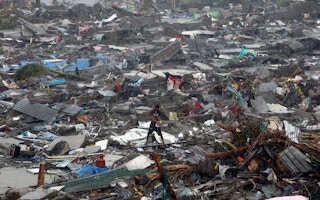Engineer Teodulfo Troyo recalls being among the last to be bused out of the Tongonan geothermal plant complex a day before Typhoon Yolanda – known internationally as Haiyan – made landfall late in 2013.
Then, Troyo was part of a team tasked to shut down the plant as a preemptive measure. He had not expected just how destructive Haiyan would prove to the plant, as well as to the larger Leyte province in the Eastern Visayas region of the Philippines, where the facility is located.
The devastation from Typhoon Haiyan took over 6,000 lives and incurred more than US$15 billion in damages. In the power sector, the country’s largest electricity distributor reported that the tropical storm toppled over more than 560 transmission towers.
“Haiyan was the first time we faced a typhoon that strong,” Troyo told Eco-Business in Tagalog, in an interview to share about post-disaster rehabilitation efforts for the plant and its workforce. “When we returned, we saw that the roof had collapsed, and most of our equipment had been rained on.”
Troyo, who has 32 years of experience working on the Tongonan site, and is now the facility’s head and chief of operations, said he is thankful that his wife and child – who were based in Ormoc, Leyte with him at the time when the typhoon struck – survived the ordeal.

Nearly 20 kilometres outside of the city of Ormoc, The Tongonan-1 geothermal power plant sits in mountainous Kananga, Leyte in the Philippines’ typhoon belt. Image: EDC
The typhoon also severely damaged Tongonan’s cooling towers and operation buildings. Troyo added that it was also a “wake-up call” for the Philippines’ largest producer of geothermal energy, Energy Development Corporation (EDC), which owns Tongonan-1.
“It spurred EDC to look into resilience projects and equip its plants to be ready, not only for super typhoons, but also earthquakes and other natural disasters,” he said.
A new life
Nearly 20 kilometres outside of the city of Ormoc, The Tongonan-1 geothermal power plant sits in mountainous Kananga, Leyte in the Philippines’ typhoon belt, which sees between five to 10 tropical storms cross its shoreline annually.
The first week after the storm, EDC mobilised its manpower in Leyte to supply potable water and some 10.7 million meals to affected communities, provided power to three hospitals and two city halls decimated by the typhoon.
Within a month after Haiyan, EDC restored operations of the geothermal power plant to help spare the people of both Leyte and Cebu provinces from blackouts, making sure they did not have to spend the Christmas season in the dark.
EDC managed to restore all its facilities in the Visayas region to normal operations some four months after Haiyan, ahead of the original forecasted nine to 10 months.
“
The facilities of Tongonan Geothermal Project are important when it comes to meeting the energy security and needs of the Philippines.
Teodulfo Troyo, chief of operations,Tongonan Geothermal Power Plant
The company would go on to take the repair and upgrade of the Tongonan-1 geothermal power plant as an opportunity to modernise its operations. It increased the facility’s capacity from 112.5 MW to 123 MW and also reinforced the site’s disaster resilience measures by adopting new technology for real-time monitoring and enhanced control and automation.
Post-typhoon, EDC has invested upwards of P3 billion (US$54 million) in capital expenditure on the plant, with a large portion used for continued rehabilitation work.
Alvin Costelo, production head of the Tongonan site, notes that the region has seen fewer plant outages since the upgrades. He said EDC started planning for long-term rehabilitation in 2014 and had aimed for the facility to enjoy a new stretch of life that would last for another 40 years. “We aimed to improve the Tongonan-1 plant’s viability and reliability until 2040,” he said.
Rehabilitation for the plant meant installing new turbine and generator rotors, as well as new generator transformers and pumps for the cooling system, among other installations. The site’s cooling towers are also now fitted with more durable fibre-reinforced plastic panels replacing the previous wood material, Costelo shared.
The Tongonan-1 geothermal power plant, which celebrated its 40th anniversary last year, is part of the Tongonan Geothermal Project (TGP) – the largest wet steam field in the Philippines – alongside EDC’s Malitbog, Mahanagdong and Upper Mahiao facilities.
With a total capacity of more than 700 MW, TGP accounts for more than half of EDC’s installed geothermal capacity – providing some 38 per cent of the country’s total geothermal energy demand.
“The facilities of Tongonan Geothermal Project are important when it comes to meeting the energy security and needs of the Philippines, but compared to coal-fired power plants that need to maintain a relatively small area to operate, geothermal and steam field operations have larger lands and more factors to take into account,” said facility head Troyo.
“As this region is also susceptible to other natural disasters like landslides and earthquakes, we have done extensive mapping of landslide-prone areas inside the steam field. We have typhoon preparedness protocols in place one week before a storm is expected to hit,” he said.
EDC’s newfound emphasis on disaster preparedness has also extended to the plant’s wider host community in the Leyte region. For example, EDC established the Kananga-EDC Institute of Technology Educational Foundation (Keitech) in 2009, a vocational school located in Kananga, a far-flung and landlocked municipality within the province to fulfil its corporate social responsibility mission.
Beyond educational assistance and practical competency training as part of an 11-month programme, extensive safety training is provided to the students too, said Erwin Magallanes, Keitech’s head of corporate relations, which is unique among other technical vocational schools.

EDC leadership was on the ground in Leyte and in discussions with national and local government officials during relief operations in the aftermath of Typhoon Haiyan. Image: EDC
Magallanes told Eco-Business that many of the students, mostly high school graduates who lack the means to pursue collegiate education, take on safety officer roles as a result of completing the programme.
He noted that all of the school’s trainees successfully pass certification exams administered by the country’s Technical Education and Skills Development Authority (TESDA). The employment rate of Keitech’s 1,200 graduates stands at about 96 per cent, and its recent batch of 60 graduates have all found jobs, predominantly in the construction sector.
EDC also continues to recruit and employ Leyte locals to be part of a growing workforce maintaining its operations at the geothermal sites across Leyte. 92 per cent of Tongonan Geothermal Project’s workforce is comprised of individuals from the province.
Last year, EDC’s 225.5-MW Palinpinon-1 plant in Negros commemorated its fourth decade in operation, generating about 11 per cent of the country’s installed geothermal capacity. This brings EDC’s total installed capacity to over 1,480MW, which currently accounts for 20 per cent of the Philippines’ total installed renewable energy capacity.


















